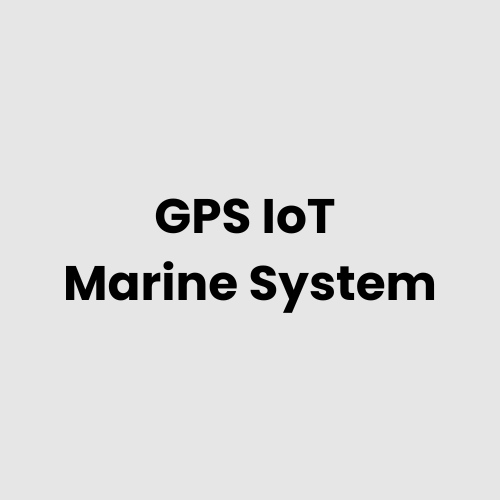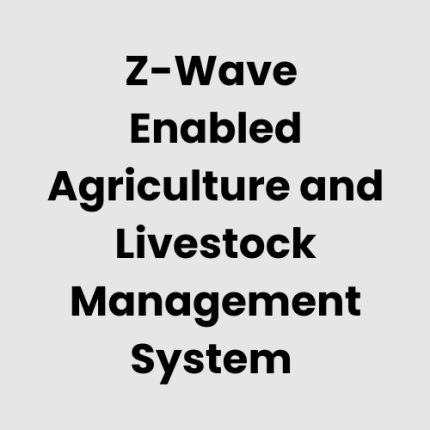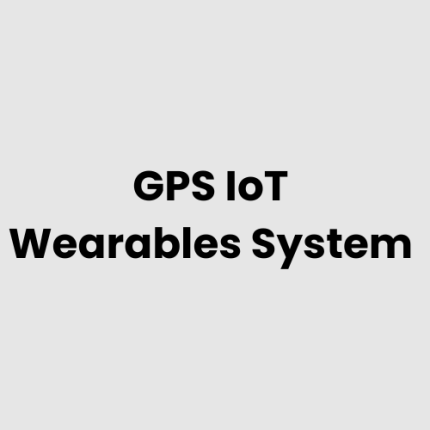GPS IoT Marine System
Explore the technical details, hardware, deployment, and cloud integration of the GPS IoT Enabled Marine IoT System by GAO Tek Inc., a leading tech provider.
Description
GPS IoT Enabled Marine IoT System – Technical Architecture
The GPS IoT Enabled Marine IoT System is designed to improve the efficiency and safety of marine operations by leveraging GPS and IoT technologies. The system includes multiple hardware components working in sync with a cloud-based platform for real-time data collection, analysis, and management. This architecture is composed of sensors, on-board computing units, communication systems, and cloud servers.
- Sensors: Marine-grade GPS, environmental, and vessel-specific sensors collect data on speed, location, temperature, humidity, engine status, and more.
- On-board Computing Unit: A robust computing system processes the collected data on-board for local analysis and ensures reliable communication with remote servers.
- Communication Systems: The system uses cellular, satellite, or Wi-Fi connections to transmit data to the cloud or local servers, ensuring continuous monitoring and control.
- Cloud Platform: The cloud platform enables real-time data visualization, predictive analytics, and remote monitoring of vessel operations from any location.
- User Interface: Marine operators access the system through a secure dashboard interface that provides insights into vessel health, safety alerts, and other important operational metrics.
Hardware of the GPS IoT Enabled Marine IoT System
- GPS Receiver: For accurate vessel tracking, location, and speed monitoring.
- Environmental Sensors: Measure parameters such as water temperature, air quality, and humidity.
- Engine Monitoring Sensors: Track engine health, fuel levels, RPM, and other performance metrics.
- Satellite Communication Modules: Facilitate data transmission in remote marine environments.
- On-board Computing Unit: An industrial-grade computer that processes sensor data and manages communication with the cloud.
- Weather and Wind Sensors: Capture data on external conditions that impact vessel operations.
- Battery Backup: Ensures system reliability in case of power failure.
- Marine Antennas: Provide stable communication in harsh marine environments.
- Marine Enclosure: Weatherproof housing that protects system components from water and corrosive elements.
Physical Placement Considerations of the Hardware
- GPS Receiver: Installed on the highest point of the vessel (such as the mast) to ensure unobstructed view of the sky for accurate location tracking.
- Environmental Sensors: Strategically placed in open areas such as the deck, where environmental parameters can be measured freely.
- Engine Monitoring Sensors: Installed near critical engine components to ensure accurate data collection related to engine performance.
- Satellite Communication Modules: Positioned in areas with minimal interference, typically near the mast or higher parts of the vessel, to ensure optimal signal strength.
- On-board Computing Unit: Located in a central, protected area on the vessel, ideally near the bridge for easy access by operators.
- Weather and Wind Sensors: Mounted on high and open areas of the vessel for unimpeded measurements.
- Marine Antennas: Placed on the exterior of the vessel, often on a raised platform, to maximize communication range.
Hardware Architecture of the GPS IoT Enabled Marine IoT System
- Data Collection: Sensors mounted on the vessel collect data in real-time on various parameters, such as location, speed, fuel consumption, and weather conditions.
- Processing and Storage: The on-board computing unit processes the raw data collected from the sensors, compresses it, and stores it locally before transmission.
- Data Transmission: The system transmits processed data to the cloud or a local server using satellite, Wi-Fi, or cellular communication modules.
- Cloud Analytics: Data sent to the cloud is stored in a secure database and analysed in real-time to generate insights on vessel performance and health.
- User Interface: A secure dashboard is provided for operators to monitor data, receive alerts, and make informed decisions based on the insights.
Deployment Considerations of the GPS IoT Enabled Marine IoT System
- System Integration: The system should be seamlessly integrated with existing vessel hardware and software. This ensures compatibility and efficient operation.
- Network Connectivity: Ensure reliable satellite or cellular communication for consistent data transmission, especially in remote or offshore areas with limited connectivity.
- Security Measures: Employ strong encryption protocols to protect data transmission and ensure the system is resistant to cyber threats.
- Environmental Adaptability: Choose marine-grade hardware and enclosures that can withstand the harsh marine environment, including saltwater, humidity, and fluctuating temperatures.
- Power Supply: Install reliable power sources with backup options, such as batteries or solar power, to maintain operation during power failures.
- Maintenance and Support: Ensure regular maintenance schedules and provide remote diagnostic support to minimize downtime.
List of Relevant Industry Standards and Regulations
- International Maritime Organization (IMO) Standards
- ISO 9001: Quality Management Systems
- ISO 14001: Environmental Management Systems
- ITU-R M.1371-5: Technical characteristics for shipborne equipment
- Radio Frequency (RF) Standards (FCC, CE)
- Maritime Safety and Security Regulations
- ISO/IEC 27001: Information Security Management Systems
- IEC 60945: Maritime navigation and radio communication equipment
Local Server Version
The GPS IoT Enabled Marine IoT System can be configured to operate with a local server setup on the vessel for real-time processing and storage of data. This local server version can help ensure data continuity even when satellite connectivity is unavailable. It can also reduce the dependency on cloud services, providing increased reliability during high seas or when navigating remote areas.
Key features include:
- Local Data Storage: On-board data storage ensures critical data is available even if the connection to the cloud is lost.
- Edge Computing: Real-time data processing at the edge to provide immediate insights, alert notifications, and decision-making support for the vessel crew.
- Offline Capabilities: Continued data collection and processing, which syncs to the cloud once the internet connection is restored.
Cloud Integration and Data Management
The GPS IoT Enabled Marine IoT System integrates seamlessly with the cloud, enabling scalable storage and advanced data analysis. The cloud-based platform provides the following benefits:
- Real-Time Data Access: Remote access to live data through secure web portals or mobile apps, allowing fleet operators and managers to track vessels and monitor performance from anywhere.
- Big Data Analytics: The cloud platform uses powerful analytics tools to process large volumes of data, identifying patterns and providing predictive insights on vessel maintenance, fuel efficiency, and safety.
- Data Storage: Secure, scalable cloud storage ensures the long-term retention of operational data for historical analysis and regulatory compliance.
- Alerts and Notifications: The cloud system sends real-time alerts and notifications based on predefined conditions, enabling proactive maintenance, safety interventions, and operational adjustments.
At GAO Tek Inc., we provide the necessary tools to help marine operators optimize their fleet’s efficiency and safety with our GPS IoT Enabled Marine IoT System. We offer solutions that integrate cutting-edge technology with cloud-based data management, all backed by our decades of expertise in delivering robust and secure systems for maritime industries. Whether you’re monitoring a single vessel or an entire fleet, our system provides actionable insights that help ensure your operations run smoothly and efficiently.
GAO Case Studies of GPS IoT Enabled Marine IoT System
USA Case Studies
- San Francisco, California
A major shipping company in San Francisco utilized our GPS IoT Enabled Marine IoT System to monitor fleet performance in real time. With real-time data analytics, the system provided key insights into fuel efficiency and route optimization, leading to a reduction in operational costs and increased safety measures across their fleet.
- Miami, Florida
In Miami, a cruise line implemented our Marine IoT system to enhance fleet management and monitor vessel health. The system’s GPS tracking and sensor integration helped streamline maintenance schedules, reducing downtime and preventing unexpected breakdowns, which greatly improved overall fleet reliability.
- New York City, New York
A logistics company based in New York used our Marine IoT system to track goods being shipped across the Atlantic. By integrating GPS data with real-time weather and engine performance metrics, the company optimized routes, reducing delays and ensuring timely deliveries even in adverse conditions.
- Seattle, Washington
A Seattle-based fishing fleet deployed the GPS IoT system to monitor both environmental factors and engine performance in real time. This data allowed for predictive maintenance and better resource allocation, significantly reducing costs and increasing operational efficiency.
- Los Angeles, California
In Los Angeles, our GPS IoT system was used by a harbour management organization to optimize ship docking and reduce waiting times. By tracking incoming and outgoing vessels, the system ensured that port resources were allocated effectively, leading to smoother operations and less congestion.
- Charleston, South Carolina
A maritime security company in Charleston adopted our GPS IoT system for its fleet of patrol boats. The system’s real-time tracking and geo fencing features provided security teams with the ability to monitor the fleet’s movements and ensure compliance with maritime laws.
- Houston, Texas
An offshore drilling company in Houston utilized our system for continuous monitoring of rig transportation vessels. The system provided real-time insights into vessel positioning, maintenance needs, and fuel consumption, which allowed for better resource management and improved operational safety.
- Baltimore, Maryland
A marine research organization in Baltimore integrated our GPS IoT system for the monitoring of their research vessels. The system collected data on environmental conditions, vessel location, and scientific equipment performance, aiding researchers in real-time data analysis.
- Portland, Maine
A marine transportation company based in Portland used our GPS IoT system to improve navigation safety and track the status of vessels. The system’s environmental sensors detected potential hazards, allowing the crew to make informed decisions and avoid accidents.
- Norfolk, Virginia
A naval defense contractor in Norfolk deployed our system to enhance vessel fleet management and maintenance scheduling. The system’s sensor integration helped detect mechanical issues before they led to downtime, ensuring fleet readiness for critical missions.
- Chicago, Illinois
In Chicago, a logistics firm integrated our GPS IoT system to monitor the transit of goods along the Great Lakes. By analysing the data collected by sensors, they were able to predict maintenance needs and prevent disruptions in their supply chain.
- San Diego, California
A recreational boating company in San Diego used our Marine IoT system to monitor fleet performance. GPS tracking and sensor data helped manage boat rental operations, ensuring boats were properly maintained and safely used by customers.
- Cleveland, Ohio
A steel manufacturer in Cleveland deployed our GPS IoT system for their transport vessels. The system’s tracking and performance monitoring features helped ensure timely deliveries of raw materials while minimizing fuel consumption, reducing costs in the process.
- Anchorage, Alaska
A fishing cooperative in Anchorage incorporated our system into their fleet of vessels. The system’s tracking capabilities helped ensure the fleet’s compliance with fishing quotas and provided real-time insights into fuel consumption and engine performance.
- Detroit, Michigan
An automotive logistics company based in Detroit used our GPS IoT system to track the movement of car carriers across North America. The system allowed for enhanced fleet management, helping to reduce transit time and improve delivery efficiency to manufacturing plants.
Canada Case Studies
- Vancouver, British Columbia
In Vancouver, a marine services company deployed our GPS IoT system for vessel fleet management. By integrating GPS tracking with engine performance data, they optimized routes and minimized maintenance costs, leading to improved fleet performance and safety.
- Toronto, Ontario
A shipping company in Toronto adopted our GPS IoT system to enhance tracking capabilities and improve operational efficiency. The system provided real-time updates on vessel positioning, environmental conditions, and cargo status, optimizing the delivery process across Canada and internationally.
At GAO Tek Inc., headquartered in New York City and Toronto, we are proud to provide advanced solutions like the GPS IoT Enabled Marine IoT System to enhance the efficiency, safety, and performance of marine operations. With decades of expertise and a focus on R&D, GAO Tek continues to deliver cutting-edge technologies that drive innovation in the marine industry. Our systems are designed to streamline operations, reduce costs, and improve safety for fleets and maritime organizations across the globe. Through seamless integration, real-time data analytics, and expert support, we empower businesses to optimize their maritime operations and stay ahead of the competition.
Navigation Menu for GPS IoT
- GPS IoT Trackers/Devices
- GPS IoT Tracking Accessories
- GPS IoT Tracking Resources
- GPS IoT – Cloud, Server, PC & Mobile Systems
Navigation Menu for IoT
- LORAWAN
- Wi-Fi HaLow
- Z-WAVE
- BLE & RFID
- NB-IOT
- CELLULAR IOT
- GPS IOT
- IOT SENSORS
- EDGE COMPUTING
- IOT SYSTEMS
Our products are in stock and can be shipped anywhere in the continental U.S. or Canada from our local warehouse. For any further information, please fill out this form or email us.
We are actively looking for partners who are like us located in the U.S. and Canada. For more information on partnering with GAO, please visit Partner with GAO Tek Inc. It lists various ways to partner with GAO, such as OEM Partnerships, Technology Integration, Distribution and Reselling Opportunities, Presenting at the Leading Event Tek Summit, Joint R&D Projects, Training and Consulting Services, Industry-Specific Collaborations, Research and Academic Partnerships.



